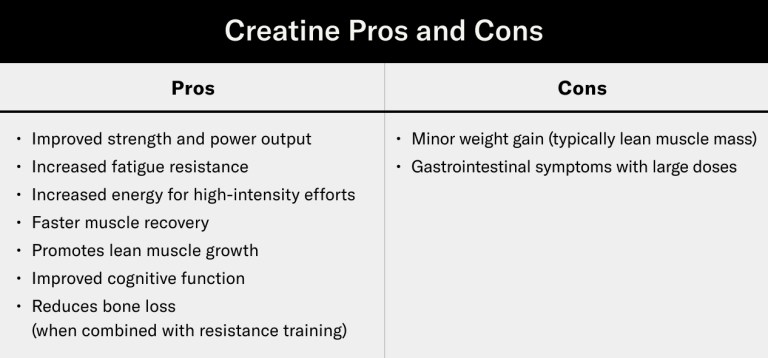Can Creatine Really Help You Gain Muscle?
Here are the pros and cons of this popular supplement so you can decide if it’s the right fit for your routine.

In the vast sea of supplements and vitamins promising to enhance your performance and boost your workout results, there are few that have been as extensively researched as creatine—and even fewer that live up to their claims.
According to a position paper by the International Society of Sports Nutrition , creatine has been the subject of over 1,000 studies, with findings indicating it provides myriad benefits and few side effects. In the same paper, researchers conclude, “creatine monohydrate is the most effective ergogenic nutritional supplement currently available to athletes with the intent of increasing high-intensity exercise capacity and lean body mass during training.” In other words, there’s a lot of scientific evidence showing creatine can help you push harder to make bigger gains.
Tonal coach and certified personal trainer Joe Rodonis experienced this firsthand when he started taking creatine a few years ago at the recommendation of his dietitian.
“When I went on it, my muscles felt fuller,” he says. “My recovery was a little bit better, too, but the main thing was—and it’s not dramatic—you feel like you have a bit more in the tank during your workout session.”
For Rodonis, that meant feeling strong through the last rep of a long workout. “Without it, I felt like I kept hitting a wall. I would literally hit failure,” he says. “You can imagine that if you’re just doing a couple more reps, a few more movements, or a couple more minutes in a workout, you can improve your training and performance capacity over time.”
Here’s a breakdown of creatine pros and cons, how it works, and how to know if this supplement is right for you.
First, What Even is Creatine?
Creatine is an amino acid, one of the building blocks of protein , explains John Christie, registered dietitian and Tonal’s Director of Applied Training Science. It’s stored in skeletal muscle and aids in the resynthesis of adenosine triphosphate (or ATP), which provides energy for short-term, maximum-effort muscle contractions. It’s this process that gives Rodonis the extra boost he needs for cranking out those last tough reps.
“Creatine can be used as an energy source for the highest-intensity efforts,” says Christie. “Having additional creatine on hand, it will be more readily available to use in those moments when it’s needed most, like with a max-effort bench press under near maximal load.” By being able to do 9 reps instead of 8 or 6 in a given exercise, you’ll accumulate more volume and better resistance to fatigue, he explains.
You can get creatine through animal proteins in your diet or as a supplement, typically in powder form that you mix with water and drink. Creatine comes in many forms, but Christie recommends looking for creatine monohydrate as it’s considered the “gold standard” in terms of bioavailability, research-backed efficacy, and safety.
When choosing a creatine supplement, look for certification from the NSF (formerly the National Sanitation Foundation, now NSF International). Supplements are not regulated by the FDA, but NSF certification indicates a product has been third-party tested and meets basic safety standards. Professional sports leagues including MLB, NFL, and NHL recommend products that are
certified by sport
by the NSF.
What Are the Pros and Cons of Creatine?
As the subject of hundreds of studies on athletes across multiple sports, the creatine pros and cons are well-established—and overall the pros outweigh the cons.

Pros:
By giving you the energy to push harder in your workouts, you’re able to make greater strength , power , and hypertrophy gains. Additionally, studies have shown that creatine can speed up recovery by reducing inflammation and increasing glycogen storage in muscles. Since intense exercise depletes stores of glycogen—your body’s main source of energy—rebuilding these stores quickly promotes recovery. In another study, creatine was shown to enhance performance during periods of increased training intensity that could otherwise lead to overtraining .
The benefits of creatine go beyond fitness, too. In aging populations , creatine has actually been shown to improve cognitive function and, when combined with resistance training, reduce bone loss .
Cons:
In the hundreds of studies conducted on creatine over the years, the only significant side effect that’s been reported is a small amount of weight gain. Because creatine increases water retention and pulls water into muscles, some of this weight gain is due to an increase in water weight while some may be due to increases in lean muscle mass.
Christie explains that this weight gain is not harmful, but could be discouraging if you’re measuring your progress by pounds or inches lost.
One study
has demonstrated that taking a smaller dose of creatine (around 2 grams per day) can improve fatigue resistance during high-intensity exercise without leading to weight gain.
While early studies linked creatine with kidney damage,
more recent research
has shown that creatine does not cause kidney dysfunction in healthy individuals. However, if you have pre-existing kidney disease or take any medication that affects your kidneys, consult your doctor before taking creatine or any other supplement.
When Should You Take Creatine?
Some supplements and nutrients are most effective when taken at a specific time–like beta-alanine before your workout or protein afterward —but timing is less important when it comes to creatine. According to a review of studies from 2021, there currently isn’t enough evidence to suggest that it’s better to take creatine before or after exercise. Instead, focus on consistency—simply taking creatine every day.
Studies have shown that, with the recommended dosage of 3 to 5 grams per day , it takes roughly four weeks to achieve peak creatine saturation in both men and women , after which that saturation can be maintained by the same dosage. The benefits of creatine aren’t often felt until creatine levels are raised following long-term supplementation, so you likely won’t see an immediate effect after a single daily dose. The creatine pros and cons remain the same no matter what time of day you take it.
“It’s more important that you’re taking it than it is when you’re taking it,” says Christie. “It’s fine to maintain reserves of creatine so you have it on board when you need it for intense training.”
How Long Should You Take Creatine?
According to the International Society of Sports Nutrition position statement , creatine has been shown to be safe and effective when taken for up to five years. That doesn’t necessarily mean there are risks beyond five years, but rather that most studies don’t follow subjects for a longer duration. However, over the course of several years, your goals and workout routine will likely change, so you may naturally take time off of creatine supplementation.
Can You Mix Creatine with Protein?
Optimal protein intake is essential for building muscle, but protein and creatine work in different ways. Creatine helps with generating the energy you need to perform in your workouts, while protein assists with post-exercise recovery and repairing damaged muscles.
It’s not surprising then that a lot of athletes who take creatine for muscle gains also supplement with protein. If you want to take both supplements, it’s considered safe to take them together for the sake of convenience. Rodonis, for example, mixes creatine into his
daily protein shake
.
Research suggests
that combining creatine with carbohydrates and protein actually increases creatine retention.
Do You Need a Creatine Loading Phase?
In the early 1990s when creatine began gaining popularity among recreational athletes, researchers believed that a creatine loading phase was necessary to build creatine stores and achieve the best results. In a creatine loading phase, athletes take a high dose of creatine, typically 20 to 25 grams daily, for 5 to 7 days. This loading phase was then followed by a standard dose of 3 to 5 grams per day for maintenance.
While a creatine loading phase can be used to boost reserves quickly, taking the maintenance dose has been shown to ultimately raise creatine levels by the same amount (over four weeks instead of one) without the gastrointestinal side effects sometimes seen when taking larger doses.
This is Rodonis’s strategy, too. He simply takes 5mg of creatine daily. “I think people overcomplicate this,” he says of regimented creatine loading phases. “It’s more about the consistency of having it every single day.”
The Bottom Line:
There’s ample research to support taking creatine as a nutritional supplement to power your workouts and give you the energy for high-intensity training. Along with protein, creatine promotes lean muscle development and muscle recovery. For most, it’s safe to take a moderate dose (3 to 5 grams) of creatine daily. Staying consistent with your creatine intake is key to seeing results.




